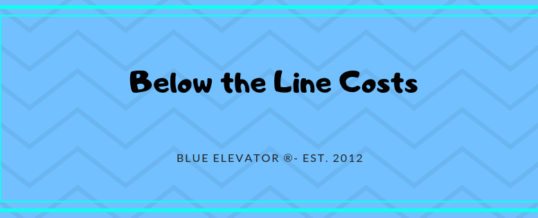
Below the Line Costs
This article will advise you on how to identify and calculate your organization’s Below the Line costs.
At Blue Elevator®, our definition of Below the Line refers to any cost that occurs below the Gross Profit line.
And, identifying your Below the Line costs is part of the process on building your Break-Even Model.
Primer Articles
If you are here for purposes of building a Break-Even Model, and you haven’t read the primer articles, here they are:
Selling, General, and Administrative
By definition, your Below the Line costs are your Selling, General, and Administrative costs.
Additionally, you can think of Below the Line costs as anything that isn’t Cost of Sales or Cost of Goods sold.
In a prior article series, we spent quite a bit of time developing Hard Costs and Soft Costs. We would also recommend you read more about Variable Costing.
You will want to identify any and all costs that aren’t attributable to directly producing revenue.
We will also add that Blue Elevator® recommends including Selling Costs “Above the Line.”
Even though the traditional line item is “Selling, General, and Administrative,” we recommend you include these Selling Costs in your Gross Margin calculation.
Typical Below the Line Costs
Here are some typical Below the Line costs:
- Rent
- Utilities
- Marketing
- Insurance
- Meals
- Entertainment
- Licenses, etc.
Practically Speaking
Practically speaking, an easy way to aggregate your Below the Line costs is to export your P & L to Excel. And, once in Excel, identify all the financial lines that comprise your Below the Line costs.
Once you’ve done this, the next step is to identify all of the vendors that comprise the activity in those financial lines.
Completeness
The key in this activity, as in any business activity, is to ensure completeness.
In this case, completeness looks like this:
- Identify every financial line NOT included in your Gross Margin calculation.
- Identify every vendor that comprises all of your financial line activity.
- Ensure you have identified 100% of your annual Total Cost.
Annual Cost
With respect to the last point, it is imperative that you identify ALL of the expenses associated with a given financial line and vendor.
For example: If you run your P & L for the last 3 months, you may miss activity that would occur in the any one or more of the other 9 months.
Some insurance premiums are paid once per year. If you don’t include 12 months of activity in your P & L download, you may understate your Below the Line costs.
And, if you understate your Below the Line costs, your Break-Even Model will not be accurate.
What it Looks Like
As you build your Break-Even Model, you will have a list of vendors with the associated annual costs.
Then, to calculate your monthly Break-Even cost, you’ll convert these annual costs to a monthly basis.
The Result
Your goal will be to have a list of every Below the Line P & L cost summarized once you’ve finished so you know the total monthly costs you need to cover every month.
When you’re ready, be encouraged to click on the next article: Break-even Point and Balance Sheet Activity.
As always, please contact us if you have any questions.
APR

About the Author:
Ken Moll is the Principal and Founder of Blue Elevator®. With professional experience spanning four decades, Ken has a breadth of foundational business knowledge rarely found – making him part of an elite class of professionals. Ken's passion is helping clients of Blue Elevator® get their “business to the next level™.”